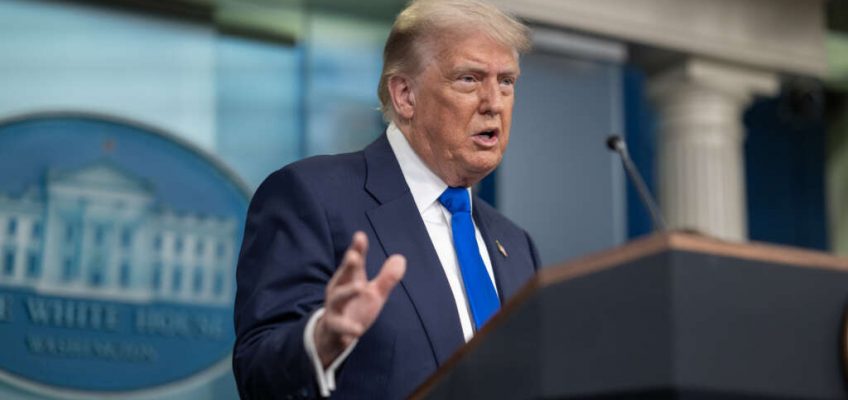Hay varias medidas migratorias que ha puesto en marcha el gobierno que dividen a los estadounidenses, mientras varias fueron percibidas negativamente.
El presidente Donald Trump en una rueda de prensa la semana pasada (Foto oficial de la Casa Blanca por Molly Riley)
Del 2 al 8 de junio de 2025, el Pew Research Center encuestó a 5.044 adultos estadounidenses sobre sus opiniones sobre algunas de las medidas migratorias más importantes del gobierno, el temor a ser deportados que expresaron cerca de un 25 por ciento de los adultos estadounidenses, y las percepciones del proyecto de ley llamado oficialmente One Big Beautiful Bill Act (Un gran y bello proyecto de ley).
Hay varias medidas migratorias que ha puesto en marcha el gobierno que dividen a los estadounidenses, mientras varias fueron percibidas negativamente.
Por ejemplo, el 50 por ciento está a favor y el 49 por ciento en contra del uso de policías estatales y locales en iniciativas de deportación; el 49 por ciento está a favor y el 50 por ciento en contra de sobre ofrecer dinero para quienes abandonan el país voluntariamente; el 49 por ciento está a favor, el 50 por ciento en contra de asignar más empleados federales en acciones para deportación.
Entre las medidas menos populares se encuentran: deportar a inmigrantes a prisiones en El Salvador (desaprobado por el 61 por ciento de los encuestados), suspender casi todas las opciones para aplicar por asilo en el país (rechazado por el 60 por ciento), terminar con el estatus de protección temporal o TPS por sus siglas en inglés (visto en contra por el 59 por ciento de los encuestados).
Las opiniones sobre políticas migratorias se dividen en gran medida según la afiliación partidista: los republicanos las apoyan en su mayoría y los demócratas las rechazan. Por ejemplo, el 78 por ciento de los republicanos y los independientes que apoyan al partido lo aprueban, y solo el 12 por ciento no lo aprueba. Por otro lado, el 81 por ciento de los demócratas lo desaprueban, con un 63 por ciento que lo desaprueba firmemente y solo el 9 por ciento que lo aprueba.
La mayoría de los demócratas (89 por ciento) apoya que los inmigrantes indocumentados puedan quedarse legalmente en Estados Unidos, frente al 41 por ciento de los republicanos. En 2017, el 61 por ciento de los republicanos y el 88 por ciento de los demócratas tenían esa opinión.
En la encuesta, la mayoría de los estadounidenses (65 por ciento) cree que los inmigrantes que viven ilegalmente en el país deberían poder quedarse legalmente.
En cuanto al proyecto de ley denominada oficialmente “One Big Beautiful Bill Act” (Un gran y bello proyecto de ley), que recortaría programas de salud, nutrición, educación, energía limpia e impuestos —proporcionando mayores ahorros a los ricos—, y destinaría más dinero al ejército y a la lucha contra la migración, los estadounidenses dicen que tendría efectos negativos para el país.
La mayoría (54 por ciento) cree que será malo para el país y la mitad (51 por ciento) espera que el proyecto de ley aumente el déficit presupuestario.
Más detalles en nuestra conversación a continuación.
Ciudad Sin Límites, el proyecto en español de City Limits, y El Diario de Nueva York se han unido para crear el pódcast “El Diario Sin Límites” para hablar sobre latinos y política. Para no perderse ningún episodio de nuestro pódcast “El Diario Sin Límites” síguenos en Spotify, Soundcloud, Apple Pódcast y Stitcher. Todos los episodios están allí. ¡Suscríbete!
The post PODCAST: ¿Cómo perciben los estadounidenses las acciones migratorias y el proyecto de ley One Big Beautiful Bill? appeared first on City Limits.




